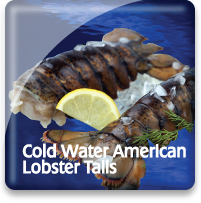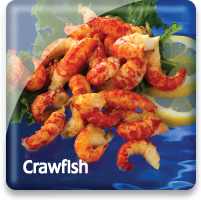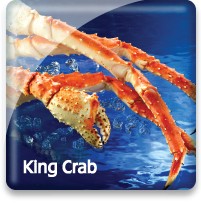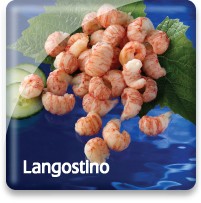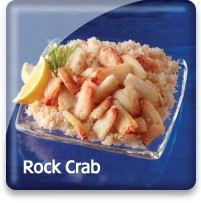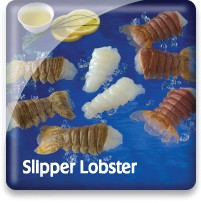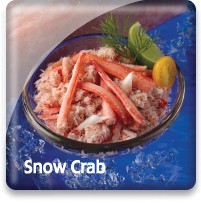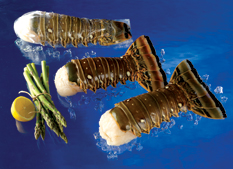
Warm Water Lobster Tails

Market Name: Eating QualitiesSpiny lobster is full, tasty flavored with a coarse texture.
Spiny lobster is the largest food export of the Bahamas.
|
Description & CharacteristicsThe Caribbean Spiny Lobster, also called Rock Lobster, is found amongst the coral reefs in the Caribbean Sea. These Lobsters are caught in cages, or harvested by divers. Panulirus argus is a firm succulent crustacean that commands the center of any seafood creation. The most prolific seafood export of this archipelago nation, Rock Lobster (Spiny Lobster) is increasingly appearing in fine dining restaurants and homes worldwide. The spiny lobster, Panulirus argus, ranges in coastal waters and the continental shelf from North Carolina east to Bermuda, throughout the Caribbean and Gulf of Mexico and south to Brazil. The name rock lobster, or spiny lobster, is interchangeable with no contextual distinction between the two terms. This lobster begins its life in the open ocean where the larvae drift on ocean currents to inshore areas. As juveniles, the spiny lobster leaves its near-shore confines. In the fall, a long, single-file line of as many as 50 migrating lobsters—each lobster maintaining contact with the lobster in front—make their way to deeper coral reefs and rocky bottom areas. This is known as the lobsters’ march. As adults, lobsters are found in crevices or dens either individually or in groups. They are nocturnal, feeding at night and returning to their den before sunrise. Spiny lobster are caught or harvested in a variety of ways subject to the laws of the country from where they are caught. Many lobsters are caught in baited traps. In some areas, it is custom to dive for lobsters, although in many cases scuba diving is not allowed; only free diving or diving with air from the surface is permitted. Divers typically use hooks to catch the lobster, preferring not to damage the lobster with spears. Dive-caught lobsters, in some instances, are caught in habitats or condos. These small structures are placed in shallow areas where lobsters congregate and mimic the lobster’s natural habitat. The top ten producing countries of Caribbean spiny lobster are the Bahamas, Brazil, Cuba, Nicaragua, United States, Venezuela, Mexico, Honduras, Dominican Republic, and Belize. United States’ most significant lobster fisheries is our own domestic fishery, primarily in Florida, in addition to imports from Brazil, the Bahamas, Honduras, and Nicaragua, in that order. Caribbean spiny lobster is a seasonal fishery. In Brazil, the season opens in May and closes in December. In most other areas of the Caribbean and Florida, the season opens either in July or August and generally closes in March. Spiny lobsters are marketed primarily as lobster tails but are also promoted as whole-cooked lobster. The market for these lobsters is primarily the United States and Europe; however, Asian markets have also been developed for whole-cooked lobster. Lobster tails are typically graded as: 5-8 oz tails are generally considered “primes” and, in many instances, this translates to a price premium. However, larger tails have recently been commanding prices at or above prime sizes depending on seasonal availability. Lobster tails should be lightly glazed, but excessive glazing, in order to add weight to the tail, has been an ongoing issue for this product. Other Resources |
Handling Instructions for Warm Water Lobster Tails
Our raw warm water lobster tails should be stored at or below 0°F (-18°C) and then thawed properly when ready to cook. The frozen shelf life is 18 months. Links to proper seafood handling instructions: NOAA - Fish Watch: Handling Seafood and A Consumer Guide to Safe Seafood Handling.
Thawing Warm Water Lobster Tails
Warm water lobster tails should be thawed in a sealed plastic container or bag and placed under refrigeration (33-39°F) for 12-24 hours or until completely thawed. Quick thawing can be accomplished by placing them in a colander and running them under cold water for 8-12 minutes or by placing them in a plastic bag and submerging them in a cold water bath until completely thawed (12-20 minutes). Thawed lobster tails should be held at 33-39°F and totally consumed within 2-3 days.
Important Instructions for Warm Water Lobster Tails
The Federal Food, Drug and Cosmetic Act now requires that all foods that are not raw agricultural commodities and that contain a major food allergen be labeled to clearly identify the name of the food source form which the allergen is derived. (21 CFR U.S.C. 343(w)(1)). The act defines eight foods, and any ingredients derived from these foods as major food allergens: Fish, Crustacean Shellfish, Milk, Eggs, Tree Nuts, Peanuts, Wheat & Soybeans. The name of the food source that must be listed on the label for fish or crustacean shellfish must be the specific type of fish or crustacean shellfish. The market names of species of fish and crustacean shellfish should be used to identify the food source of these two major food allergens. If you intend to re-pack these seafood products, be sure the allergen is declared in either one of two ways:
1) Within the list of ingredients
or
2) In a separate “Contains” statement immediately after or adjacent to the list of ingredients.
Consult the Fish and Fishery Products Hazards and Controls Guidance, Fourth Edition, Chapter 19 for more detailed information on the labeling of food allergens.
Cooking Tips
Care must be taken to not overcook lobster. However, even slightly overcooked lobster is a wonderful taste treat! Links to recipes: Buying Frozen Lobster Tails - How To Thaw Frozen Lobster Tails - Cooking Frozen Lobster Tails, How to Cook Lobster Tails.
The Bahamas
The Bahamas (Commonwealth of The Bahamas) is an independent country consisting of over 700 islands that start just off the east coast of Cuba and stretch northward over 800 miles to just off the east coast of Florida. This Tropical paradise is known as a favorite tourist destination and also for its delicious Bahamian warm water lobsters. Bahamian Lobsters make up over 50% of all landings by weight and comprise over 95% of the total value of the entire seafood production of the country. Lobster is the king of all Bahamian seafood. Currently The Bahamas have little commercial aquaculture production. However, the Bahamian Department of Marine Resources is promoting cobia and other saltwater finfish aquaculture.
Bahamian lobsters are captured primarily by divers that may employ compressed air (not scuba gear) to assist them in hooking and spearing. Recently “casitas” or special mock shelters have been used to help attract the lobsters so they all congregate in one spot and are therefore more efficiently harvested. Because of the economic importance of the commercial lobster fishery, the Department of Marine Resources is working on fishery improvement projects (FIPs) that will move the fishery to be deemed sustainable under the United Nation’s FAO Code of Conduct for Responsible Fisheries. They are working with the commercial lobster fishermen, the World Wildlife Fund, and large end users of Bahamian lobster tails. This critically important Bahamian fishery is well on its way to becoming certified as a sustainable fishery. This will benefit not only future generations of Bahamian fishermen, but also all those who love this tropical paradise seafood delicacy.
Go Blue! Seafood Sustainability Spectrum*Click here for an explanation of our Sustainability Spectrum 
Sustainability AssessmentWarm Water Lobster (also called spiny or rock lobster) is found in tropical and subtropical waters all over the world. Sea Port imports Caribbean red spiny lobster, which is overexploited throughout its range. Spiny lobster management in the Caribbean still faces many challenges despite some progress made. Spiny lobster from the Caribbean is primarily caught in dive and trap fisheries, which result in high rates of bycatch of undersized juvenile lobsters, and interactions with threatened and endangered sea turtles. Other finfish and invertebrates are also caught as bycatch in spiny lobster traps. The majority of the catch in the Bahamas is from casitas, or artificial habitat, used to attract lobsters. Minimal habitat impacts occur from dive fishing and traps, but lost gear and use of artificial habitat may have negative impacts on ocean floor habitat. Recently a small-scale artisanal Warm Water Lobster fishery in Mexico, Siam Ka’an achieved MSC certification.
Environmental Impact: HighInadequate resources lead to lack of enforcement of any management measures that are in place. Heavy fishing effort and juvenile lobster bycatch has led to population declines.
Sustainability Improvements NeededBetter management is needed. Some areas have had luck with community-based area management, as it involves the communities that depend on the resource in protecting their livelihoods.
Actions that Sea Port is UndertakingRecently “casitas” or special mock shelters have been used to help attract the lobsters so they all congregate in one spot and are therefore more efficiently harvested. Because of the economic importance of the commercial lobster fishery, the Department of Marine Resources in the Bahamas is working on fishery improvement projects (FIPs) that will move the fishery to be deemed sustainable under the United Nation’s FAO Code of Conduct for Responsible Fisheries. They are working with the commercial lobster fishermen, the World Wildlife Fund, and large end users of Bahamian lobster tails. This critically important Bahamian fishery is well on its way to becoming certified as a sustainable fishery. In other regions of the Caribbean, multinational foodservice companies are working with Honduras and the Global Fish Alliance to improve that country’s lobster fishery. Sea Port will continue to support the Caribbean lobster fishery as it moves steadily towards improved sustainability. We created the sustainability assessments for each of our seafood items in order to reveal the existing and potential environmental impacts and risks that are associated with producing them for human consumption. This allowed us to establish the starting position for each of our seafood items along our progressive Go Blue! Seafood Sustainability Spectrum®. These assessments are only a single snapshot in time and because of this, we will continue to assess and update the critical sustainability needs associated with our supply sources and issue updates to the Go Blue! Seafood Sustainability Spectrum® as needed. There is a growing global awareness for the need to assure the sustainability of farmed and wild caught seafood and because of this; all around the world positive changes are rapidly occurring at all levels of the seafood supply chain. We will continue to spread this growing awareness and work with our many industry partners to improve the sustainability of all seafood, which we believe is the ideal protein of choice to feed an ever growing world population. Our Go Blue! Seafood Sustainability Spectrum® serves as our compass and yardstick as we strive to move all our products forward to becoming more sustainable. Please join us in this committed quest and Catch Our Wave® to sustainability by choosing a diverse variety of responsibly produced seafood as part of your diet.
|


